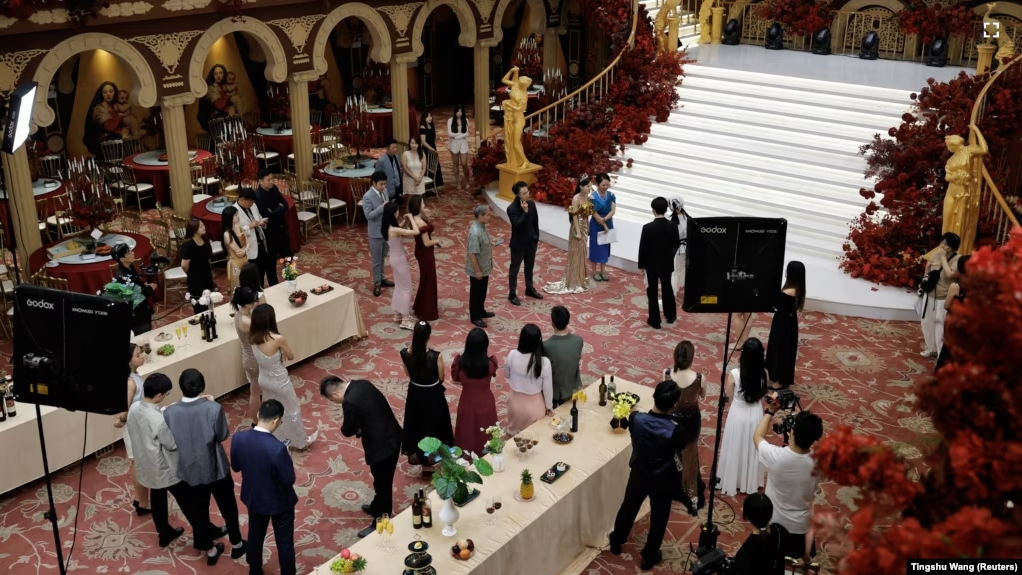On a film set in China, a 69-year-old actor is playing the part of a wealthy family leader.
In “Grandma’s Moon,” actor Zhu Jian celebrates his birthday with a costly dinner party. And he is about to get a big surprise: One of the workers at the party is his granddaughter.
But there is another big surprise.
“Grandma’s Moon” is not a movie or even a television show. Instead, it is a series of short videos, called a micro drama. Creators shoot them vertically for easy watching on cell phones. Each episode is only minutes long.
Most of the people watching “Grandma’s Moon” are middle-aged workers and retired people. Zhu said that these viewers do not go to movie theaters anymore. He added that it is so easy “…to hold a mobile phone and watch something anytime you want.”

Micro dramas use story-telling methods like hooks and plot twists to keep millions of viewers watching on their cellphones. And these audiences are very willing to pay for more.
The cliffhangers at the end of each episode are critical to the success of micro dramas. Cliffhangers keep a viewer interested and wanting to watch more. Audiences must pay for the next episode to find out what happened.
Changing the industry
Reuters News Agency reports that China’s micro drama industry is worth $5 billion. Micro dramas are shot quickly and with little money. The first few episodes are often free. But to watch the whole micro drama series, audiences may have to pay money to watch additional episodes.
Experts say micro dramas are successfully competing with China’s film industry.
The micro drama leader is the app Kuaishou. The app is responsible for 60 percent of the top 50 Chinese micro dramas last year. That information comes from Endata, a company that studies media.
Douyin is owned by internet technology company Bytedance, which is also popular with micro drama fans. Other Chinese social media apps like Xiaohongshu and YouTube competitor Bilibili have announced plans to make more.
Micro dramas are now spreading to the United States.
“China discovered this audience first,” said Layla Cao, a Chinese producer based in Los Angeles. Hollywood, she says, has not yet.

Popular Storylines story-telling techniques
Micro dramas are successful not only for their story-telling methods but also for their interesting plots.
Many popular micro dramas for Chinese audiences are stories about revenge or reaching higher social status. Their popularity is happening at a time when making money and changing your status in China is difficult. Youth unemployment is also high.
The micro dramas often “show people who one day are lower class and the next day become upper class …” said a 26-year-old screenwriter. Writing under the name Camille Rao, she recently left a low-paid job in the traditional film industry. Now, she writes micro drama stories for American audiences.
Criticisms of micro dramas
China’s Communist Party has been critical of micro dramas. Between late 2022 and early 2023, China’s regulatory agency, the National Radio and Television Administration, or NRTA, removed 25,300 micro dramas.
In June, the Chinese government began requiring some creators to register micro dramas with the NRTA. The regulator did not answer Reuters’ request for comment.
Actor Zhu added that the plot is often unreal or over-the-top; “…so it catches people’s attention and a large audience wants to see them,” he said.
Zhu said he loves classic films, like “Casablanca.” And like many other film lovers working in micro dramas, he thinks they have limited artistic value. He said, “I see it as fast food…”
However, loyal fans of micro dramas disagree.
Huang Siyi is a 28-year-old customer service agent. She enjoys watching romantic micro dramas because “the acting is good and the male and female leads are good-looking.”
She adds that it is easy to get hooked on micro dramas.

Explosive growth
Micro dramas can be made with little money. The amount of money needed to make them can be between $28,000 (200,000 yuan) and $280,000 (2 million yuan), the market research company iResearch reports.
In the central Chinese city of Zhengzhou, creators are making “Grandma’s Moon” with not much money and not much time. The show was filmed in just six days.
As micro dramas grow in popularity, actors’ earnings have grown too.
Many Chinese micro drama producers have their eye on Western markets.
Micro dramas designed for the West are often made by production and acting crews in Los Angeles and shot on location. The stories are in English and often involve wealth, cheating partners, and miracles.
One of the apps that distributes micro dramas in the West is called LoveShots. In one of its latest micro dramas, a paralyzed woman miraculously regains her ability to walk. Then, she walks in to find her husband cheating on her.
I’m Andrew Smith. And I’m Anna Matteo.
Antoni Slodkowski reported this story for Reuters with additional reporting from Tingshu Wang and Xiaoyu Yin. Anna Matteo adapted it for VOA Learning English.
______________________________________________
Words in This Story
vertically -adv. straight up or at an angle of 90° to a horizontal surface or line
episode -n. an event that is part of a longer story or of history or a life but which is viewed as complete by itself
hook -n. a device especially in music or writing that catches the attention
plot twist -n. literary technique that introduces a radical change in the direction or expected outcome of the plot in a work of fiction
audience -n. a group that listens or watches (as at a play or concert)
revenge -n. to get even for a wrong done
status -n. position or rank in relation to others
screenwriter -n. a writer of scripts and often shooting directions of a story prepared for movie production
miracle -n. an extraordinary event taken as a sign of the supernatural power of God
paralyzed -adj. rendered incapable of movement or action
